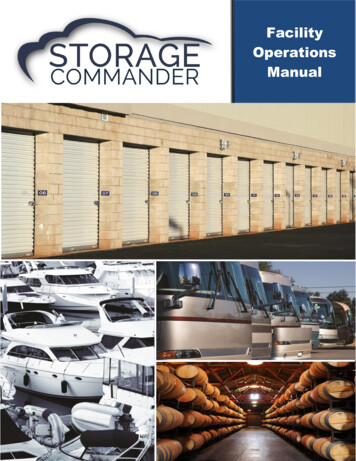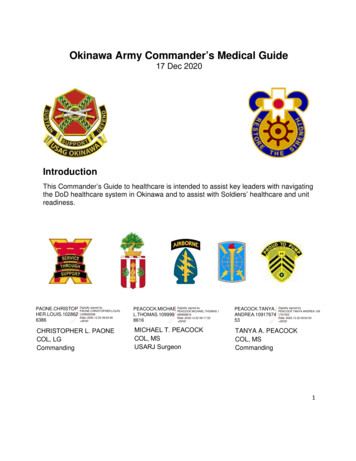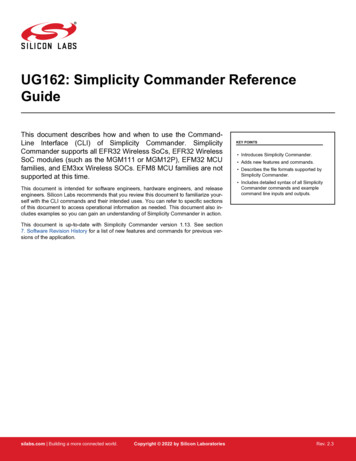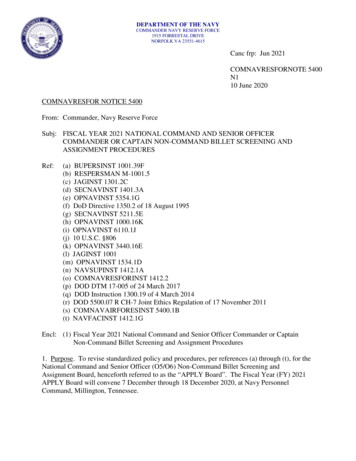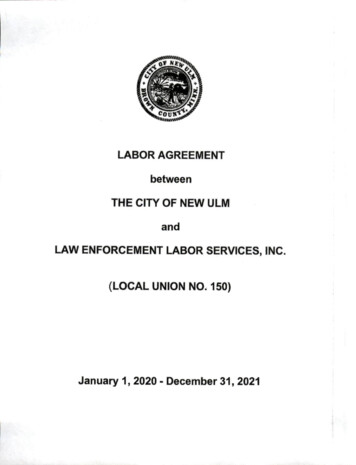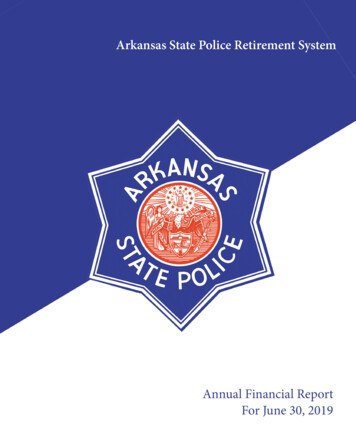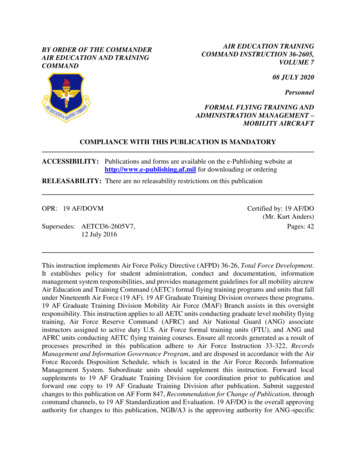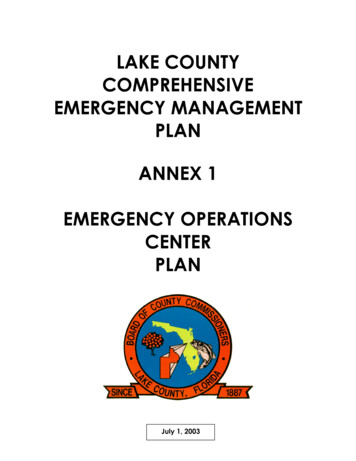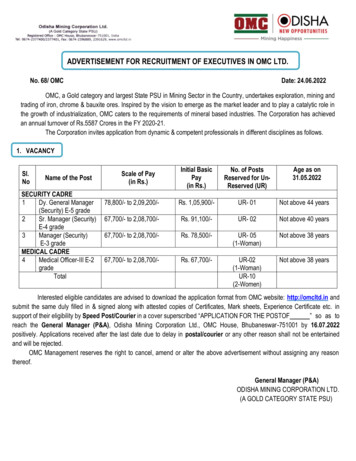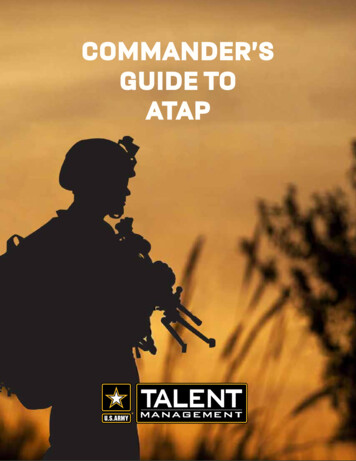
Transcription
COMMANDER’SGUIDE TOATAP1
2
Commander’s Guide to the ArmyTalent Alignment Process (ATAP)I.The Army Talent Alignment Process (ATAP).01A.B.C.D.E.F.What is ATAP?Benefits of ATAPPrinciples and Characteristics of ATAPThe Army Talent Alignment Algorithm (ATAA)Business RulesThe ATAP MarketplaceII. Commander’s Role in ATAP.07A.B.C.Phase I: Set the MarketPhase II: Execute the MarketPhase III: Clear the Market IIIIII. Assignment Interactive Module 2 (AIM 2.0).17A.B.C.D.E.Unit InformationMarket DashboardVacancies and Mission Essential Requirements (MER)RequisitionsTalent MarketplaceIV. Brevet Promotions.26A.B.C.V.Brevit PromotionsCritical ShortagesBrevit Position in MarketplacePromotion Boards OPT-IN & Opt-Out. 30A.B.C.D.E.F.Promotion Board (Opt-Outs)Terms for Opting Out at PromotionImpact on ATAPPromotion Board (Opt-In)Terms for Opt-In at PromotionImpact on ATAPVI. Conclusion.36A.Closing Commentsi
This Page Intentionally Left Blankii
APPENDIXES:I.Market Place Business Rules and Responsibilities.38II. ATAP – “A Way” – Captured from EXORD.60III. Points of Contact .62IV. Useful Links.63V. Position Vacancy Spreadsheet Example.64VI. Unit Information.66VII: Market Dashboard –*Courtesy US Army Human Resources Command.71VIII: Our Vacancies *Courtesy US Army Human Resources Command.73IX: Our Requisitions *Courtesy US Army Human Resources Command.81X: Talent Marketplace *Courtesy US Army Human Resources Command.83XI: 4187 Example – Brevet Promotion Nomination.91iii
This Page Intentionally Left Blankiv
CHAPTER 1:The Army Talent Alignment Process (ATAP)Former Secretary of the Army, Honorable Dr. Esper, on 17May2019: “Commandersnow have the authority to attract talent through the Army Talent Alignment Processusing the Assignment Interactive Module 2.0 (AIM 2.0). With this authority comes theresponsibility for commanders to advertise unit vacancies, interact with potential hires,and signal hiring preferences in AIM 2.0.”A.What is ATAP?1.B.The Army Talent Alignment Process (ATAP) is a decentralized, regulated,market-style hiring system that aligns officers withjobs based on preferences. These preferences are shaped by the uniqueknowledge, skills, behaviors and preferences (KSB-Ps) ofeach officer and the KSB-Ps desired by commanders for theiravailable assignments.Benefits of ATAP1.The Army Talent Alignment Process offers many benefits over thetraditional assignment system by empowering individuals andorganizations with detailed information to inform their decisions.2.ATAP provides individual officers greater freedom tochoose from a wider variety of assignments which best fittheir KSB-Ps, while organizations now have the freedom tosearch across the entire slate of moving officers to preferencethe right people for their teams.1
3.More benefits of ATAP:a)Officersi.Gain transparency in the assignment processii.Individual preference carries more weightiii. Improves officers’ ability to manage their own careersb)Unitsi.ii.iii.c)Armyi.ii.iii.iv.v.C.Gain transparency in the assignment processBuild teams based upon their unique KSBsImproves readiness by employing officers’ talents effectivelyGains insight into its officersIncreased ability to impact long-term retentionManage talents vs. manage strengthManage talent using multiple variablesLearns about officer preferencesPrinciples and Characteristics of ATAP1.Six principles and four essential characteristics define ATAP and willproduce optimal outcomes for participating units and officers.a)Principles:i.Every officer is in ATAP and self-professes theirtalent information using AIM 2.0.ii.Every unit is in ATAP, advertises and describes theirorganizational vacancies, and commanders activelyparticipate in the hiring process using AIM 2.0iii. Readiness determines which positions are in ATAP andavailable for fill.iv. Every job is filled through ATAP using AIM 2.0; units provide thedata to turn a vacancy into a job.2
v.Readiness, professional development, and senior leaderguidance determine the eligibility rules for assignments.vi.ATAP operates with increased transparency and, if themarket fails, OPMD, HRC clears the market with an emphasison officer and unit preferences.b)Characteristics:i.Thick – contains a numerous and proportionateamount of unit positions to officers to produceoptimal outcomes for both participants. Thiscreates competition and increases chances for anassignment match.ii.Fast – ATAP, executed through AIM 2.0, is easy touse, customizable, and filterable, permitting officersand units to quickly sort through hundreds ofrésumés or job descriptions to focus on the groupof candidates or assignments that are most deservingof their attention.iii.Smart – governed by business rules that providethe right incentives for all participants.iv.Transparent – participants have access to assignment andcandidate information, and understand the businessrules that shape how officers match to jobs.D.The Army Talent Alignment Algorithm (ATAA)1.ATAP uses a mathematical algorithm called the Army Talent AlignmentAlgorithm (ATAA) to match officers to vacancies. The algorithm is based ona Nobel Prize winning preference matching model.3
2.The ATAA is an iterative method proven to best match preferencesbetween two participants, in this case assignments and officers. Thealgorithm is designed to match available officers with validated positions.3.The ATAA was piloted in the 20-02 assignment cycle and will be used asthe primary slating tool for the 21-02 market and beyond.4.For more information on the ATAA, please visit the following link:https://www.youtube.com/watch?v 9mEBe7fzrmI&app desktop.E.Business Rules1.Appendix I: Marketplace Business Rules and Responsibilities provides asummary of the ATAP Business Rules that (1) govern unit responsibilities,officer responsibilities, and HRC responsibilities; (2) permits the Army tochange an assignment, even when officer and unit preferences align, tomeet Army Readiness requirements.2.The business rules incorporate Army requirements, professionaldevelopment, and Army Senior Leader (ASL) guidance. The rules arepresented by phase and provide tasks throughout each phase to guideunits and officers through the ATAP Process.3.Commanders must review the ATAP Business Rules to understand theirrequirements as well as the requirement of officers in their formation.F.The ATAP Marketplace1.The ATAP process will be executed in three phases:a)Phase I: Set the Market. This phase begins with identifying unitposition vacancies and officers available to move and ends withvalidating both the unit positions to be filled and the population ofofficers available. Units will inventory their officers, validateprojected position-vacancies, and post detailed position descriptionswithin AIM 2.0 describing the KSBs desired for their assignments.Officers identified to move will update their résumés in AIM 2.0,4
describing the unique KSBs they possess. HRC will validate the list ofvacant positions in accordance with manning priorities and seniorleader guidance.b)Phase II: Execute the Market. This phase begins when ATAP opensand ends with a predetermined date-time-group published by HRC.ATAP opens with officers reviewing vacant unit positions, interactingwith unit POCs or the position incumbent to gather moreinformation, then preferencing their desired assignments in rankorder. Units assess available officers’ résumés, dialogue with officerswho may have yet to express interest, conduct interviews, andpreference available officers in rank order.c)Phase III: Clear the Market. This phase begins with the conclusion ofthe market and ends with officers receiving their request for orders(RFOs). Officer and unit preferences will be the primary factors todetermine assignment matches using the ATAA.5
This Page Intentionally Left Blank6
CHAPTER II: Commander’s Role in ATAPFormer Vice Chief of Staff of the Army, GEN McConville, on 17May2019: “Commanders bear the responsibility in the Army Talent Alignment Process for attracting andhiring talent for their organizations.”A.Phase I: Set the Market1.A commander and unit have various roles and responsibilities duringthe ATAP process. Commanders do have the ability to delegate someof these roles in order to maximize the efficiency of their talent search.Below you will find a list of recommended actions to complete.2.A unit commander, Brigade Executive Officer (XO), Brigade S1, orBrigade Strength Manager cannot be solely responsible forpreparing a unit to navigate ATAP. While the process may be viewedas time consuming, establishing lines of effort (LOEs), taskorganizing, and taking a team approach to ATAP will pay dividendsto the unit. It is highly recommended that units create an internalconference style meeting prior to a manning cycle to maximizeefforts for Talent Management. Below is a list of items to assist withframework and meeting development.a)Task organize. Task organize to maximize the use of newauthorities. An example of a new authority is a BrevetPromotion that will be discussed later in the guide.b)Identify all movers. It is critical to ensure your officersidentified to move (OIM) are accurately reflected up front andas soon as possible. This will increase your chances ofreceiving a backfill during ATAP. Additionally, identifyingofficers early ensures they are not disadvantaged by enteringthe market late, which could potentially limit the officer’soptions and reduce assignment opportunities7
c)Identify all vacancies. Compete the positions that willactually be vacant. For example: if a commander isoutbound, but you have an officer on staff already slatedto take that position, compete the staff position to preventbreaking a market match. It is also important toadjudicate legal actions that will result in a vacancy in atimely manner, as well as identify projected losses due tomedical or retirement.d)Determine priority of position vacancies. This is criticalwhen building your manning document. There are a finitenumber of officers available during an ATAP cycle.You need to prioritize your positions to ensure your unit’smust-haves are validated by HRC.e)Identify desired Knowledge, Skills, Behaviors, andPreferences (KSB-Ps) of inbound officers. This will bethe most time-consuming process during your unit talentmanagement process. It will likely involve multiple follow-on touchpoints to ensure your team has identified thecorrect KSB-Ps for your unit’s vacancies. Below is a list ofsuggestions that will maximize time and efficiency.i.Knowledge management is critical during yourtalent management process as the data you capturecan be re-used in later manning cycles.Maintaining a record of your KSB-Ps, dutydescriptions and requirements by position willgreatly minimize the time a unit spends on futuretalent management conferences.ii.Before the talent management conference, haveyour officers currently filling the soon to be vacantpositions provide a list of KSB-Ps that made themsuccessful or would have made them successful intheir position. This will assist units in identifyingKSB-Ps necessary for potential officers to beeffective in the position and organization.8
iii. When organizing KSB-Ps for your unit’s vacancies,think in terms of “required” vs. “desired.” RequiredKSB-Ps are the attributes which are a must-haveprior to assuming the position (e.g. Brigade EngineerOfficer – Basic Mathematics). Desired KSB-Ps arethe attributes which may be helpful or nice to havebut not a requirement to be successful in theposition (e.g. Brigade Public Affairs Officer – WebDevelopment).iv. Identify what experiences your unit desires for anofficer to fill a specific position. AIM2 provides thefollowing experiential and education lists to helpyou narrow your search: additional duties, militarytraining, and licenses and certifications. While youmay not find an officer that meets all of therequirements, this will help you narrow down yourcandidate pool.v.Provide incumbent or unit point of contact (POC)information. Incumbents provide a great resourceto officers in ATAP. They can communicate withpotential replacements and translate requirementsand expectations to officers interested in assignmentto your unit. In cases where an incumbent is notcurrently in the position to be filled, units can usethe requisition POC field to serve the same functionof an incumbent.vi.Provide agreed upon unit comments. Unitcomments provide organizations an opportunity tohighlight specific requirements about a positionthey want interested officers to know. This greatlyenhances a unit’s ability to explain why certainKSB- Ps are required for the position as well asprovides a venue for units to highlight items notavailable in the KSB tabs in AIM 2.0.9
3.Commander Solicitationa)Commander solicitation is highly encouraged during the ATAPprocess. This can be accomplished in a number of ways. AIM 2.0provides various venues for units to provide information toprospective officers interested in coming to your organization.Please see recommended methods for successful solicitation below.i.Upload a command video link and welcome letter to the AIM2.0 Unit Page. Ensure your unit website URLs are up to dateand working. Provide location and installation resources available to interested officers. Provide links to social media sitesfor officers to view (can be delegated to unit PAO).ii.Identify opportunities to dialogue with prospective candidatessuch as CCC/ CGSC students. Dialogue and engagement arean important part of ATAP. Visits to locations such as CCC andCGSC provide a face-to-face engagement that couldpotentially impact officer preferences. Understanding thatbudgets and timing may not allow for all units to schedule TDYtrips, VTC, DCS sessions, and telephonic interviews are alsogreat mediums to reach out to officers moving within theupcoming assignment cycle.iii.4.When necessary, develop and advertise incentives available toan officer interested in your unit on your AIM 2.0 unit page.Incentives can be developed with branch proponents andOPMD, HRC to increase interest. Incentives include but arenot limited to: brevet promotions, military training(e.g. Pathfinder, Airborne), short command queues, etc.Brigade S1/ Strength Manager Preparationa)Adjust Year Month Available to Move (YMAV) for verified officersidentified to move (OIM) as soon as possible. The majority of officerswill be identified during the unit’s internal conference/ process, butthere may always be unexpected movers identified throughout theprocess. As stated earlier, identifying officers early providesan added benefit for the officer as entering the market late could10
b)Submit Mission Essential Requirements (MER) through ATAP in AIM 2.0.i.Submission of your MER requirements in ATAP is amulti-faceted process with the implementation andincorporation of KSB-Ps into AIM 2.0. As discussed earlier,identifying information for data fields in AIM 2.0 during the unittalent management conference will greatly assist the unit S1and/ or unit strength manager in uploading the informationinto AIM 2.0.ii.Fill out information and KSB-Ps for each advertisedposition. It is critical for personnel officers to keep thisinformation up to date throughout the ATAP market.See Tip below.iii.Rank order all position vacancies to indicate commander’spriority to fill. This informs HRC of a commander’srequirements list, enabling validation of priority vacancieswithin a unit. Failure to provide a priority for positions, mayresult in critical vacancies going unfilled.TIP: Create a document or spreadsheet with the required data fields in AIM2.0. Have your talent management team input that information during thetalent management process. When the MER opens, S1s and strengthmanagers will be able to copy and paste the following fields: Duty Title,Duty Description, Unit Comments, and Special Remarks. This will save yourS1 team significant time during the MER process. KSBs will have to beinputted manually through the KSB tab. An example spreadshteet is availablefor use in Appendix V: Position Vacancy Spreadsheet Example.5.Commander Coachinga)It is expected that unit commanders coach OIMs on completion oftheir AIM résumé, career development, and participation in themarketplace. Some suggested topics on commander coaching areprovided below. (Brigade Commander can delegate to BattalionCommander)11
i.ii.b)AIM2 résumé to include formatting, content, observed KSB-Ps.Career Development to include DA PAM 600-3 requirementsand selecting assignments based on an officer’s KSB-Ps.For questions that cannot be answered by unit commanders orpersonnel officers (S1s), it is recommended that the officer bereferred to their HRC Career Manager.TIP: When coaching OIMs, it is important they understand the dynamics ofthe market. OIMs need to preference as early in the market as possible.This ensures units receive feedback that the officer is interested early, whichcan initiate the dialogue process. The top three (3) units or top ten percent(10%) that an officer preferences will auto-generate a notification to the unit.It is highly encouraged that officers reach out to units early, if they have notbeen contacted by a preferenced unit.B.Phase II: Execute the Market1.After a unit submits its MER for the upcoming ATAP cycle, HRC will executetheir internal processes for validating requirements. Requirements will bevalidated based on Active Component Manning Guidance (ACMG).2.Brigade S1/ Brigade XO Screeninga)Once HRC validates unit vacancies, the Brigade XO and Brigade S1should provide a prioritized list to their Brigade Commander.b)Prioritizing vacancies will maximize a Brigade Commander’s time,as well as the brigade staff’s time, when searching for potentialcandidates interested in the unit.c)After vacancies have been prioritized, the Brigade S1 shouldconsolidate officer résumés, initiate the brigade’s engagementstrategy, and reach out to potential candidates forinterview scheduling.12
d)3.The Brigade Commander must identify personnel within the brigadewho he or she wants to assist in interviews and hiring decisions.To ensure interviews are fair and consistent for all potential hires,it is recommended that units establish and use an interview criterion.Officer Screening and Interviewsa)Field Grade Screeningi.Field Grade screening has typically been a Division-levelfunction supported by Brigade Commanders. BrigadeCommanders should seek guidance from the DivisionCommander on the process for selecting andinterviewing field grade officers within their division.ii.Once the Division Commander gives guidance on field gradescreening, candidates should be screened through theirésumé and by filtering of KSB-Ps within AIM 2.0. This willassist commanders in identifying potential fills andnarrowing the pool of likely officers to interview.iii. Upon completion of interviews, candidates should be scored onqualifications, suitability, and preference of the unit. Thisinformation should be shared with interviewed officers, sothey can determine the best way to preference in the market.This will help facilitate a match through ATAA and ATAP.b)Company Grade Screeningi.As commanders compete company grade positions for theirorganization, it will be useful for commanders and/orcommander’s representatives to maintain dialogue withbranches at HRC for officers currently at the captain’s careercourses or other functional area professional military education(PME) venues. This will greatly assist units in initiatingdialogue with potential officers.13
ii.Once brigades have a list of candidates, interviewers shouldreach out to interested officers for interviews. Upon completionof interviews, candidates should be scored on qualifications,suitability, and preference of the unit. Interviewers shouldprovide candid and honest feedback to the Brigade Commanderas well as the interested officer prior to preferencing in themarketplace. This will help facilitate a match through the ATAAand ATAP.TIP : A strategy for conducting interviews is to take a branch-specificapproach to interviewing interested officers. Simply, a logistician interviewslogisticians interested in applying to the unit. While branch-specificinterviewers are not a requirement, the commander should provide clearguidance on the development of the unit’s engagement strategy. Thepersonnel conducting interviews and assisting in hiring decisions need to betrusted agents within the organization capable of providing unvarnished andhonest reviews of potential candidates to the commander.4.Brigade S1 Final Inputa)Upon completion of interviews for potential candidates, the BrigadeS1 should provide feedback to officer branches at HRC. Feedbackshould include rank order of officers the units wish to preference.b)Preferences should also be inputted into AIM 2.0. This will allow thealgorithm to slate officers with units based on their preferencesin ATAP.TIP : DMSL (brigade-level) preferences must be approved by the DML(division-level) Commander prior to submission in AIM 2.0 to ensureconcurrence. This step is necessary to support Senior Command Authorities.C.Phase III: Clear the Market1.Initiate Sponsorship. Commanders will ensure that officers inbound totheir unit are sponsored in accordance with Army Regulations.14
2.Confirm Incoming Officer Data. Brigade S1s provide the unit commanderwith officer data prior to arrival. (e.g. KD Requirements, Joint Data,Personal Considerations (EFMP/ MACP), etc.3.Brevet Positions. Officers assigned through ATAP as incoming to a brevetposition cannot be diverted or reassigned by the senior commander(See Chapter IV: Brevet Promotions).15
This Page Intentionally Left Blank16
CHAPTER III: Assignment Interactive Module 2(AIM 2.0)A.Unit Information1.As stated in Chapter II, dialogue and commander solicitation are anintegral part of ATAP. AIM 2.0 provides a capability with the “Our Unit”tab to highlight items a commander deems important for potentialofficers to know about his or her organization. Just as an Officer RecordBrief (ORB) and résumé are an officer’s handshake with a unit, the unitinformation page serves the same function as an initial handshake from aunit to an interested officer.2.The unit information page can be accessed by selecting the “Our Unit”tab on an organization’s AIM 2.0 home screen. The unit information pageprovides a place to add details about the organization to include but notlimited to: the mission; training/career opportunities; command priorities;locations (especially if geographically dispersed); organizationalstructure; skills/ military occupational specialties (MOS) associated withthe unit; and key points of contact. The unit can also upload documents orprovide links to social media and other websites that can best articulatetheir nuances. Please see below for a list of tabs available to build theirunit information page.a)Unit Details – this tab has a location for unit Point of Contact,Attachments, and the Unit Website Address (URL).i.Point of contact – this section provides the following fields:name, email, duty title, and phone number.ii.Attachment – this section allows a unit to upload a PDF file forofficers to download or view. This file can be a unit brief,commander’s philosophy, etc.iii. Website – this section provides a field for units to input theirweb address (URL)b)Mission – this tab provides a free text field for the unit to enter theirmission statement.c)Organization & Higher Headquarters – this text field provides alocation to define organizational structure such as task organizationof the unit and its higher headquarters.17
d)Officer information: this tab has three separate sub-tabs to inputinformation that applies to officers of specific grade fields. The threesub-tabs are:i.Company Grade Officer Informationii.Field Grade Officer Informationiii. Warrant Officer Informatione)3.B.Additional Unit and Installation Information – This is a text field toprovide additional unit information and installation information.Examples include links to the local area, medical/ hospitalinformation, housing, employment, etc.See Appendix VII: Unit Information for screen shots of a blank “Our Unit” tab.Market Dashboard1.Each unit has a market dashboard in AIM 2.0. The market dashboard is atool that assists unit representatives with tracking inbound/ outboundofficers, markets, and the MER.2.Data within the market dashboard is displayed through interactive barcharts, pie charts, and graphs. Unit representatives can hover over graphsto display information.3.C.See Appendix VII: Market Dashboard for more information.Vacancies and Mission Essential Requirements (MER)1.The MER is the unit’s list of vacancies they want to compete at the HRCOfficer Distribution Conference. The MER is maintained by a unit’sstrength manager.18
2.Units provide input to their MER by keeping, adding, deleting, modifying,and prioritizing vacancies. This process assists HRC in adjudication and thedistribution process. The MER occurs over a one-month period, usually 30days before the market opens.3.To view unit vacancies, strength managers click on the “Our Vacancies” tabwithin AIM 2.0. (See Appendix VIII: Our Vacancies)4.Strength Managers will enter position information validated by the unitchain of command. Fields include:a)Position Informationi.ii.b)Duty Title – the duty title is the vacant position at the unit.Duty Description – the duty description is generated andvalidated by the respective leadership of the unit or section thatowns the billet. The duty description should detail significantduties and responsibilities of the positionPosition Detailsi.ii.iii.iv.v.vi.UICRank/ CONGRAOC/ MOSSQIASIParagraph and Line NumberTIP : Incorrect UICs are the leading cause of vacancies competing poorly inthe Distribution Conferences.c)Knowledge, Skills, and Behaviors (KSB)i.Additional Duty List – units can list additional duty experiencethey want applicants to have.ii.Desired Civilian and Military Experience – a list of civilian andmilitary jobs.iii. Licenses and Certifications – a list of professional licenses andcertifications of interest to the unit.19
iv.v.TIP :Personal Attributes – characteristics, attributes, and skills theunit desires in an applicant.Study Knowledge – a list of hobbies, activities, and self-studyknowledge that may be of interest to the unit.The KSB list is updated through an annual review process. If you havea recommendation to update the attribute or experiential lists, youcan email the Army Talent Management Task Force to request theupdate. All updates will be considered during the KSB annual review.See Appendix III: Points of Contact for email.d)The “Unit Comments” section provides a free text box for the unit tocommunicate position details to prospective candidates. This entryshould emphasize information that will attract the right officers andcan expound upon the knowledge, skills, and behaviors they shouldpossess to succeed in the job.TIP: Units can use the “Unit Comments” section to highlight the KSBs andexperiences an officer will or should attain, while assigned to the unit. Thisassists officers in making their preference selection if they are seeking KSBsand experience, which will make them competitive for future assignments.e)The “Special Remarks” section is a text box the unit may use tocommunicate information to HRC about the vacancy and can includeadditional information such as security requirements, etc. This fieldcan only be viewed by HRC and not a prospective officer.f)The “Incumbent” section provides the contact information of theindividual currently filling the position as well as a point of contactfield for the hiring manager or designated unit representativeauthorized to speak about the position. Some positions may nothave incumbents and will only list a point of contact.5.Once all positions have been completed, the strength manager mustprovide a priority for the position. This will ensure each position isassigned the correct Manning Guidance Code, ensuring the positioncompetes correctly during the distribution conference.20
6.It is recommended that unit commanders receive regular updates on thestatus of their positions. If all fields are completed correctly, the Marketplace Dashboard will reflect the unit’s MER completion percentage.a)Requisitions1.Upon completion of the HRC Distribution Conference, allvalidated requisitions will move to the “Our Requisitions” tab inAIM 2.0. The list can be exported to a spreadsheet for unit use.2.The unit can track requisition status to ensure positions arefilled, placed into the market, and have the necessaryinformation. During the market units can update Duty Title,Duty Description, Unit Comments, Incumbent Information, andKSBs as needed to accurately reflect position details.3.After a requisition has been filled, units can click on the greenicon next to the position to see the officer’s résumé assigned tofill the position.4.For a visual depiction of the “Our Requisitions” tab please seeAppendix X: Our Requisitions.E.Talent Marketplace1.The “Talent Marketplace” tab is located below the “Our Requisitions” tabin AIM 2.0. This is the primary tab units will use during the marketplace.Select the correct distribution cycle to view your validated requisitions byusing the drop-down box at the top left of the page (e.g. 21-02).a)If a unit clicks on “View OP
management process. It will likely involve multiple fol low-on touchpoints to ensure your team has identified the correct KSB-Ps for your unit's vacancies. Below is a list of suggestions that will maximize time and efficiency. i. Knowledge management is critical during your
